Glasgow Cathedral is one of a few Scottish churches to survive the Reformation of 1560 undamaged.
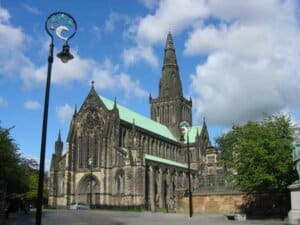
Glasgow Cathedral
The History of Glasgow Cathedral
The development of Glasgow Cathedral and its host city is a story forever associated with the legend of one man. He is St Kentigern, now better known as St Mungo.
What little information we have about St Mungo comes from a biography written by Bishop Jocelyn (1174-99), who is said to have, “wandered through the streets and lanes of the city” in search of information about Mungo, who the ‘common people’ invoked in times of strife.
Tradition dictates that he was born in Fife at some point in the second decade of the 6th century. His birthplace is said to be the spot where his mother came ashore after being cast adrift on the River Forth as punishment for committing adultery. His father is unknown.
As a young man, Mungo was brought up in Fife and trained for the priesthood by St Serf at a local monastery. When he eventually left the security of monastic life, he headed for the west coast of Scotland.
As he travelled, he met a very old and sick man called Fergus who was nearing the end of his life.
After his death, Mungo placed the body on a cart pulled by two bulls and continued until he reached a cemetery, one consecrated by St Ninian, on the banks of the Molendinar Burn, a tributary of the River Clyde. It was here he buried Fergus.
Towards the middle of the sixth century, the King of Strathclyde, Roderick Hael chose Mungo as his bishop and for more than ten years, he worked as a missionary converting local people to Christianity.
As a large community grew up around him, he built a small wooden church on the eastern slope of a hill overlooking the Molendinar Burn. The area became known as Clasgu (the dear family) and ultimately grew into the city of Glasgow.
Glasgow Cathedral stands on the site of the original church
Glasgow Cathedral, the High Kirk of Glasgow, stands on the site of the original place of worship which sadly current scholars know little about. King David I consecrated a stone church on the same site in 1136. That building was destroyed by fire and nothing now remains. We do know it occupied the area covered by the nave of today’s cathedral.
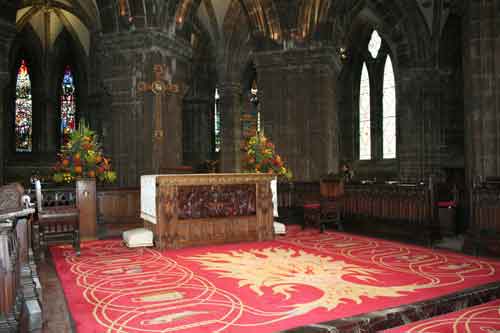
After the fire, rebuilding began, and in 1181, the Melrose Chronicle recorded that Bishop Jocelyn, “was gloriously enlarging his cathedral in Glasgow.” It was ready for dedication in 1197.
After Jocelyn’s death, his successor continued the building work, but when Bishop Bondington arrived on the scene in the mid-13th century, he brought new ambitious plans.
Large extensions were added to the choir, the lower church and chapter house.
They transformed the building and essentially formed the heart of the cathedral we know today. Two large towers were later erected at the west end but were demolished in the mid-19th century.
The role of the cathedral during the medieval period was not one we would recognise today. Although it served the community as a parish church it was also where the bishop placed his ‘Cathedra’, or chair of office. In order to mark the status of the cathedral, services with particular solemnity and dignity took place in the choir.
They consisted of a daily round of psalms, readings, prayers and anthems, similar in many ways to the great monastic houses of the day.
John Knox
John Knox was born in Haddington near Edinburgh about 1505. Initially ordained as a priest in the Roman Catholic Church in Scotland he later studied with Calvin in Geneva before turning away from the Catholic faith and embracing Protestantism.
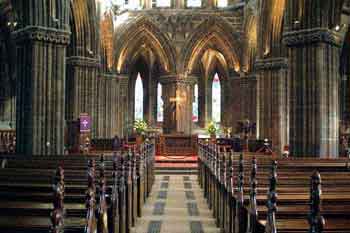
In the upheaval of the Knox led Scottish Reformation, the Catholic Mass and adherence to the Pope’s authority were swept away in an orgy of violence and destruction.
Compared to many of Scotland’s other religious houses, Glasgow Cathedral escaped relatively unscathed.
The town’s citizens were simply not prepared to see the destruction of a building that was not only a place of worship but also a focal point of the community and took up arms to protect it.
James Beaton, Glasgow’s Roman Catholic archbishop fled to France taking many precious artefacts with him and in time the cathedral was fully converted to ‘reformed’ worship.
Glasgow Cathedral: A feeling of space
Today a visitor to this Gothic cathedral would find the exterior rather austere but the inside, awe-inspiring. When you enter the nave, you get an immediate feeling of space. The vaulted roof soars to 105 feet and you can see the entire 285-foot length of the building.
A number of regimental colours adorn the nave’s walls, reminding us of Scots who have fought in more modern conflicts: the 3rd regiment of the Foot Guards, later the Scots Guards, the Cameronians and the Highland Light Infantry – a regiment particularly associated with the city of Glasgow.
A screen, dating to the 15th century, almost hides the choir (used today as a parish church) from the nave.
At the east end of the choir is the chancel, a magnificent setting carpeted in an extravagant red and gold and backed by the great east window which shows the four evangelists – Matthew, Mark, Luke and John each with his traditional emblem.
Glasgow Cathedral: Magnificent vaulted ceiling
The design of the cathedral is unusual. It sits on a slope that runs from west to east allowing its most exceptional feature to be built; a lower church, topped by a magnificent vaulted ceiling, which takes up the area under the choir.
It houses the crypt, chapter house and Blackadder Aisle. However, the central feature of the lower church is the tomb of St Mungo, which sits directly below the altar of the main church.
A brightly embroidered cloth, dedicated in 1973 in the presence of Princess Margaret covers the tomb.
“The orange side of the cloth, facing west, depicts an open furnace with the cross in the centre. Superimposed is a design that combines a golden Burning Bush and St Mungo’s tree, whose structure also recalls the shipyard cranes on the Clyde.
“The side panels north and south, symbolise Flight, inspired by the bird of St Mungo legend. The predominant green facing east recalls the Clyde with the silver of St Mungo’s fish and bell. Ship’s rigging is the basis of the design for the six kneelers.”
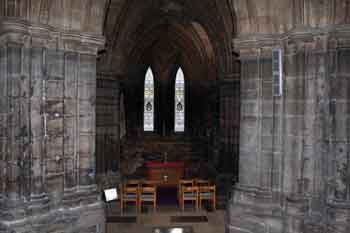
At the east end of the lower church are four small chapels.
They include the Chapel of St John the Evangelist, which contains part of what is thought to be the ancient well used by St Mungo.
Another is the Chapel of St Andrew dedicated to the nurses of Scotland. Within its simple setting sit eight chairs.
Their seats are embroidered in a design inspired by a passage from the Bible, Genesis 1:29-30, in which God says, “Behold I have given you every herb bearing seed which is upon the face of all the earth and every tree…”
A group of volunteer nurses completed the needlework and to ensure authenticity, experts examined medieval herbs in the University of Glasgow collection.
More Scottish history articles
The lime-washed Blackadder Aisle is particularly significant with links to Fergus, the old man who St Mungo laid to rest.
Like many churches, stained glass windows add much to the splendour of the building. They also have an important role in telling a story.
In the middle of the 12th century, the Abbot of St Denis in France expressed the philosophy of the western church on stained glass. Quite simply stained glass was the “Bible of the poor.”
Stained glass windows
Glasgow Cathedral has one of the best collections of modern glass in Britain, installed over a number of years from 1936. A particularly fine example is one of the windows in the upper chapter house which depicts the life of St Mungo.
The beautiful Millennium window installed in 1999 is another fine example. Its distinctive blue glass is a striking feature on the north wall of the nave. The trades window in the south aisle shows the arms of the Trades House of Glasgow, an organisation whose early members saved the cathedral from the Reformation mob.
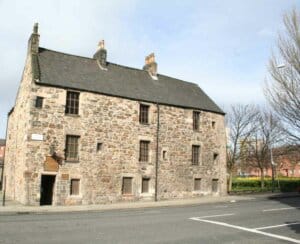
Despite the ravages of the Reformation, the Scottish parliament of 1587 heard Townhead, the area around the cathedral, celebrated in glowing terms.
It was noted for its, “grite and sumptuous buildings of grite antiquity, “and described as, “apt for royal visits and nobleman’s residences.”
Today the area is perhaps less sumptuous. Nonetheless, it is home to a number of important buildings.
Among them, is the Provand’s Lordship, Glasgow’s oldest house built in 1471 as part of St Nicholas Hospital, by the Bishop of Glasgow Andrew Muirhead. The building later became home to the canons from the cathedral chapter.
The Glasgow Necropolis
Overlooking the cathedral is the Glasgow Necropolis, a vast Victorian garden cemetery, the final resting place of not only the great and good of Glasgow but the common man and woman too. More than 50,000 souls lie here. A statue of John Knox looks down from the highest point.
Today the cathedral is a living working entity with regular Church of Scotland services. Historic Environment Scotland which maintains the building said, “The city of Glasgow takes great pride in the building that is the most impressive survivor of the age which created it.”
Let Glasgow flourish
The modern city is immensely proud of its motto, inspired by St Mungo, “Let Glasgow Flourish” and although the cathedral is no longer at the heart of the city, without it there would have been no Glasgow.
Glasgow Cathedral – Visitor Information
For information on opening hours, cost of entry and other tips to help you plan your visit, go to the Glasgow Cathedral website.